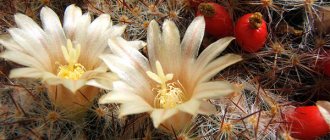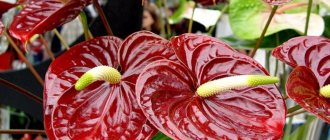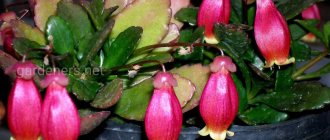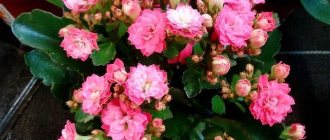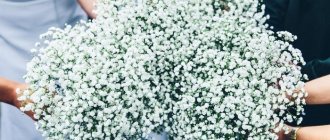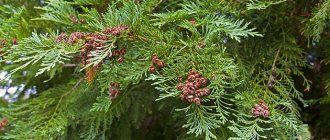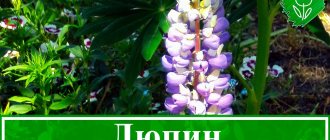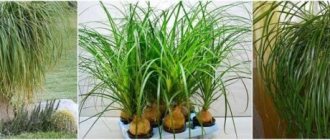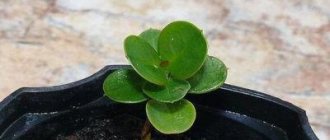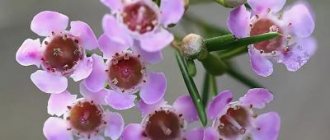It is not difficult to propagate the variety you like. More often, vegetative methods are used for these purposes, which is explained by a decent rooting rate, the availability of planting material and the slight complexity of the process.
When transplanting, an adult anthurium bush can be easily divided into several parts, as well as the basal shoots that form from time to time with their own root system can be separated from it.
Such anthurium babies, as well as stem layering or cuttings used for propagation, fully retain their parental properties. Therefore, even owners of rare hybrids do not have to worry that the beauty of the inflorescences or foliage will be lost.
However, not all vegetative propagation methods are equally effective when it comes to producing new anthurium plants.
Blooming species and their photos
Andre
Epiphyte up to 1 meter high. The color range ranges from white to red-scarlet. The cob is white or yellow, 15 cm in length. How often does the plant bloom? With proper care, it blooms all year round, delighting owners with abundant buds.
Scherzer
Small in size, with an unusual cob. Its peduncle is 50 cm high . An inflorescence of an unusual shape appears on it - an elongated, red cob twisted into a spiral. 8 cm long.
Minnesota
Bright red-scarlet bracts and an ear that changes its white color to yellow, and then to green.
Dark Red
Bracts of all shades, from crimson to wine-burgundy and from brown to black.
Utah
Anthurium Utah has large inflorescences with a textured glossy blanket with a diameter of 14 cm. The spadix and bracts are violet or deep purple. Old inflorescences can be identified by the green color at the base of the spathe.
Tennessee Pink
It has a curious quality - over time, its cover and cobs change color. At the beginning of growth, the bracts are soft pink in color, after a while they become completely green.
Green "Midori"
Completely green from the very beginning of flowering. The cob is also green.
Read more about the types and varieties of anthurium here.
Varieties of home anthurium
Epiphytes are usually grown indoors.
The most common anthuriums with colorful blankets:
| View | Description | Flowers | Cover |
| Andre | The first one is cultivated. It has year-round flowering. | Red, white, purple, pink, maroon. | Bright, pointed, turns green after flowering. |
| Dakota | The most popular. Can reach 1 m. | Sunny. | Purple. |
| Scherzer | The petioles are small. | Yellow, scarlet, snow-white. | Round, heart-shaped, orange, red, white with dots. |
Valued for their decorative leaves:
| View | Description | Leaves |
| Crystal | Decorative, with dim flowering, pleasant smelling. | Heart-shaped, with light expressive veining patterns. |
| Multicut | Low-growing vine. | Narrow, dark green glossy, similar to long fingers. |
With a variety of bedspreads.
| View | Cover |
| Blush, Tennessee, Lady Love | Pink. |
| Dark Red Anthurium, Otazu Brown, Black queen | Dark red shades. |
| Midori | Green. |
| White, White Heart | White. |
| Picasso, Lemona | Yellow. |
| Obake, Mauna Loa Obake, Rainbow Obake | Two-color. |
When do the buds of “male happiness” begin to appear and how long does the process last?
Anthurium is completely devoted to flowering, only in conditions close to a tropical climate. This is a capricious plant. When does the “male happiness” flower begin to bloom and how long does the plant bloom? If the owner has taken into account all the nuances of the content, then flowering lasts from the beginning of spring until autumn, but many species have only winter flowering.
Important! Anthurium flowering lasts up to 4 weeks, provided there is warmth, sunlight and air humidification. The plant does not like to be moved frequently. In winter, the soil should not dry out. Shadow and drafts will negatively affect its development.
Anthurium bloom is like nothing else. During the female phase, only the stigmas are visible, and the stamens are hidden in the perianth. Drops of sweet liquid are visible on the stigmas, to which insects react. As the liquid dries, stamens appear. As they develop, they cover the stigma with their length. After pollination, the stamens retract and the anthurium again takes on the appearance of the female phase. The duration of flowering ranges from several hours to several weeks. Depends on the variety.
Conditions for growing and caring for anthurium
In order for the plant to feel comfortable, maintenance regimes are observed.
| Factor | Spring Summer | Autumn winter |
| Location | East, west window. Access to fresh air without drafts. | South-facing windows, insulated from cold air flows. |
| Lighting | Scattered bright light. | |
| Temperature | Optimal + 28 °C. | +16…+18 °C. |
| Humidity | Maintain high:
| |
| Watering | As the top layer of soil dries out, when the leaves droop a little. Moisten all the soil in the pot and immediately drain the water from the pan. Use only settled, room temperature. | |
| Top dressing | Once every 1-2 weeks, fertilize for flowering plants, depending on the condition. | Refuse or once a month half the dose. |
How and why to replant and rejuvenate anthurium
After purchasing a flower, it undergoes adaptation to indoor conditions for two weeks. After which, regardless of the time of year, it needs to be replanted:
- The plant is taken out of the old container without shaking off the soil and transferred to a larger pot, maintaining the same planting depth.
- The volume of the new shelter should be larger than the root system by 2-3 cm in depth and width.
- Soil composition: leaf soil, peat, vermiculite or perlite, sand (1:1:1:0.5) or only sphagnum moss without additives.
- Drainage - pieces of bark, charcoal.
Then the flower is replanted annually in the spring. As the plant grows, it is rejuvenated by separating the children from the mother bush, placing them in different pots.
If young shoots do not form for a long time, the entire trunk is trimmed, almost at ground level. Such pruning stimulates root formation and the appearance of new shoots.
Anthurium flowering and its absence
Anthurium can bloom all year round. But there are situations that lead to flowers drying out:
- the plant is aging - cut off along with the peduncle;
- pollination by insects, setting berries - wait for the seeds to ripen or cut them off.
In the middle zone, due to less light and lower temperatures on the windowsill in winter, anthurium may slow down its growth, in this case there are two possible options:
- They create a dormant period - follow the maintenance rules for the winter period, the main thing is not to allow the temperature to drop below +15 °C.
- They maintain the active phase (flowering and growth) - they are placed away from the window, where it is warmer, illuminated with phytolamps, and watering and fertilizing regimes are observed.
Sometimes flowering does not occur. There are several reasons leading to this:
- Failure to comply with the conditions of proper care: lack of light, low temperature, dry air, excess or lack of watering, lack of fertilizers.
- Too large a container - the plant devotes energy to growing roots and leaves.
- Small pot - lacking nutritional factor.
- Feeding with the wrong fertilizers requires phosphorus, potassium, microelements and fewer nitrogen compounds.
- Frequent movement of the flower, stressful situations.
- Inaccurate replanting, the plant is damaged.
How to extend the process?
Anthuriums bloom at home almost all year round. Usually from February to November. Even cut flowers remain in bloom for almost four weeks.
In order to prolong the magnificent flowering, you need to adhere to certain conditions: a balance of light, temperature, soil and humidity. A balanced microclimate with bright, diffused lighting will allow the anthurium to bloom all year round:
- Temperature 18 degrees.
- Bright, diffuse lighting.
- Spacious potty.
- Watering is moderate.
- Wet air.
- Nutritious soil.
- No drafts.
- Regular feeding.
Problems with growing, diseases and pests of anthurium
If not properly cared for, the plant may become sick and be attacked by pests. As a rule, this can be noticed by leaf disease.
| Symptoms Manifestations on leaves | Problem | Elimination |
| Round brown, yellow spots, the appearance of holes. | Anthracnose, septoria | Damaged leaves are destroyed, the roots are disinfected, and the soil is replaced. The plant is placed in a place with reduced humidity, watering is reduced, and it is not sprayed. In case of severe infection, use Fitosporin, Fundazol, Silk (2-3 times every 2 weeks). |
| The roots are rotten. Loss of shine, paleness, then blackening. | Root rot | Cut off the affected parts. Treated with Fitosporin, Maxim. Replant into new soil and pot. |
| Curling, shrinking, appearance of a white coating. | Powdery mildew | Place in a warmer place. Sprayed with preparations: Topaz, Acrobat. |
| Dark red spots at the bottom, light at the top, wilting. | Rust | Use Topaz, Ordan. |
| Yellowing, sticky coating, green insects visible. | Aphid | The soil is covered with a film, the leaves are washed with a soap solution. Treat with onion infusion or Fitoverm. Difficult cases - Actellik, Karbofos. |
| Inside there are black spots, blurry yellow-green stains, drying out, falling off. | Trips | Spray with Fitoverm (3-4 times every week). |
| The thickenings are white-golden. | Shchitovka | Collect insects. Apply a garlic solution with soap, if this does not help, wipe with kerosene. |
| The appearance of yellow dots and cobwebs. Drying, curling. | Spider mite | Use Fitoverm. |
| White plaque on sore spots. | Mealybug | Wash with soapy water, then repeat several times after a week, and also spray with garlic infusion or Fitoverm. |
Why are there no buds?
Note! Anthurium begins to bloom at the age of one to 4 years.
Your plant is probably not ready yet.
- The soil is not moist enough.
- There is not enough light.
- Anthurium is subject to drafts.
- Repeated rearrangement.
Watch the video about why Anthurium does not bloom and 7 ways to make it bloom:
On our website there are other materials about anthurium: diseases and pests of the flower, reproduction, benefits and harm for humans and animals, differences from “female happiness”.
What you need to know when starting to propagate plants at home
There are several ways to propagate anthurium, so the grower can choose the one he likes best, focusing on the condition and appearance of the flower.
In any case, it should be remembered that anthurium, like all Araceae, is poisonous. The juice of the plant, when it gets on the skin or mucous membranes, causes unpleasant symptoms characteristic of allergies (itching, rash, redness, irritation, and so on). The intensity of their manifestation depends on the sensitivity of the skin. If the juice is accidentally swallowed, a serious stomach upset is likely. Therefore, when starting to propagate anthurium, be sure to wear gloves, and when finished, wash your hands thoroughly with soap.
The soil in which the flower is sold in the store is absolutely not suitable for it. It is quite difficult to find a substrate intended specifically for epiphytes or aroids. You can use soil for orchids, Saintpaulias (violets) or Bromeliads - it meets the acidity requirements (pH 4.5–6.5), but this is still not an ideal option.
Soil for Aroids is quite rare on sale, but all components separately are quite accessible, so it is better to mix the substrate yourself
Therefore, it is better to mix the soil yourself. Before planting, it must be disinfected by exposing it to cold, heat or steam.
- Fertile turf, leaf humus, perlite or vermiculite (1:3:1). Small pieces of birch charcoal (about 5% of the total volume) are added to the finished mixture.
- Soil for azaleas or rhododendrons, peat chips, pieces of pine bark (about 1 cm), expanded clay (up to 3 mm in diameter), crushed sphagnum moss. The substrate turns out to be light and loose, but at the same time retains moisture well.
It is quite possible to find an alternative to the missing components. Perlite and vermiculite will be replaced by coarse river sand, sphagnum by ordinary marsh moss or coconut fiber, birch charcoal by crushed chalk or crushed pumice.
Grown anthuriums are transplanted into pots shaped like bowls - shallow and wide. The root system of the plant is superficial. A thick layer of drainage material is required. It should fill at least a quarter of the pot's volume.
Anthurium does not need a voluminous deep pot, its roots are superficial - such a container greatly inhibits the development of the above-ground part of the plant
Established young anthuriums are watered abundantly before being transplanted into a container and soil suitable for adult plants. Then the soil is not moistened for 3–4 days. During the first month you need to be especially careful with watering - there is a high risk of rot developing.
Care
Water after the soil has completely dried.- Moist air is required.
- There should be no drafts.
- Increase diffused lighting for 12 hours a day. Stretching of leaf petioles and pale coloring indicate a lack of sunlight. In winter, illuminate with LED lamps.
- Plant in a tight pot with nutritious, loose soil so that oxygen can freely penetrate to the roots of the plant.
From the video you will learn how to care for Anthurium:
Anthurium is a flower of extraordinary beauty. This plant will delight and delight its owners throughout the year, subject to all the above recommendations.
Anthurium propagation by leaf
Like other representatives of the Araceae family, this crop forms roots on leaf petioles with extreme difficulty and reluctance. Reproduction of anthurium by leaves in the vast majority of cases ends in failure. Unlike zamioculcas, which forms small nodules at the base of the leaf and has its own root system of children, anthurium rots and the leaf dies.
If the gardener's collection includes decorative foliage anthurium species, you can try using the leaves to produce young rosettes. True, in this case it is better not to immerse the petioles in water, but to carefully bury the leaf plates in wet perlite.
In warm air and maintaining constant humidity, after 3-4 weeks the plant sometimes forms roots that are suitable for further growing of anthurium children.
Flowering problems
“Male happiness” is a capricious flower. Even if flower stalks and buds appear on it, they may never open. Let's look at the main reasons for poor quality flowering.
Flowers are drying
If the flowers bloomed more than a month ago, then their drying is a biological process. New buds will be released to replace those that have bloomed, but if it is the young, and sometimes even unopened, buds that dry out, this indicates improper care.
Drying of flowers in the bud phase indicates too dry air
Drying of flowers and buds is primarily caused by insufficient humidity around the plant and lack of nutrition. If the anthurium’s soil dries out completely between waterings, and the room is very dry and hot, then it experiences stress, there is not enough moisture for the growing flowers, and they dry out. Subsequently, drying of the leaves and even death of the plant is possible.
Quite often, the flowers of anthuriums that stand on a south-facing, hot window dry out, even in a warm wind, and even more so in a draft.
When moving a flower from place to place, the flowers or leaves may also dry out.
Anthurium flowers turn green
Very often the color of anthurium flowers changes from bright to green. You shouldn’t be afraid of this - this is not a disease, just a natural cycle of the end of flowering. Usually green flowers are simply cut off. But if all the buds on the plant immediately begin to turn green, this may be a sign of a lack of nutrition when the anthurium completes its growing season and is preparing to rest.
How to help a plant bloom?
Adviсe:
- Anthurium is known to love moisture, but you should not leave water in the tray. This can cause root rot.
- If your plant has stopped growing, it means it needs replanting. It is worth replanting the plant when it is not in bloom.
- Flowers that have faded should be cut off, because... the plant continues to give its power to the dried flower.
- Anthurium does not like dense substrate. This substrate does not allow air and moisture to pass through. This provokes the proliferation of harmful microorganisms. For male happiness, the soil should be loose and not caking.
- You have taken good care of the plant, but still there is no flowering, then you can heat the water to 40-50 degrees and water the anthurium. This procedure should be carried out in mid-to-late February.
If all points are followed, anthurium flowers will not keep you waiting long and will decorate your room. You just need to bring it closer to the natural conditions of its habitat. Taking into account all the above useful tips and recommendations for caring for anthurium, you will get a healthy, flowering and evergreen indoor plant. For many years it will delight you with bright, unusual flowers.
Artificial stimulation of anthurium to flower
If no care mistakes were made when growing a houseplant, but it still does not bloom, you should try artificial flower stimulation. One of the experienced flower growers made a remark that anthurium responds well to watering with moderately hot water.
The method of watering the roots with settled water (+40..+50°C) before the start of the active growth phase (at the end of February) promotes the so-called “shake-up”, which subsequently has a positive effect on the formation of inflorescences.
Another effective method of stimulating flowering is treating anthurium roots during transplantation with special herbal stimulants.
By providing the anthurium with proper care and competent support, you can expect one hundred percent return from it in the form of exquisite budding.
How to care after purchase?
- When purchasing, you need to inspect the roots of the anthurium. To do this, remove it from the pot: there should be no rotten roots. If you couldn’t do this in the store, then carry out an inspection immediately upon arriving home.
- If the flower looks healthy and the root system is in order, then place it in light partial shade, monitor the humidity of the soil and air, and after a week transfer it to a new pot.
- If there are rotten roots, then they must be cleaned of soil, washed, trimmed and sprinkled with crushed activated charcoal or charcoal. Then it is advisable to treat with a fungicide (Topaz, Skor, Previkur, Fitosporin-m and others).
- For transplantation instructions, see a separate article - link on the page above.
Roots in drainage holes and root ball examples
Preparation
To propagate the plant you will need:
- containers with holes in the bottom;
- substrate for planting;
- drainage;
- "Epin", "Kornevin" or "Heteroauxin";
- a sharp knife sterilized with potassium permanganate or alcohol;
- sharpened wooden stick.
To root a divided bush, you will need small wide containers and soil in which adult anthuriums are grown with the addition of perlite, coconut fiber or sphagnum moss. The seeds are sown in the same substrate, only the amount of baking powder is increased. Cuttings are planted in perlite or sphagnum.
Plant anthurium cuttings or divisions in plastic or plastic containers. If you don’t want unpresentable containers to spoil the interior, place them in a decorative flowerpot or a beautiful larger pot, and fill the free space with damp sphagnum or acidic peat.
